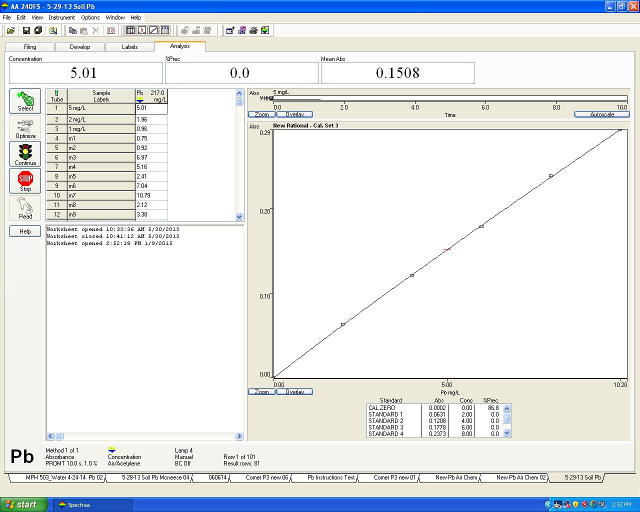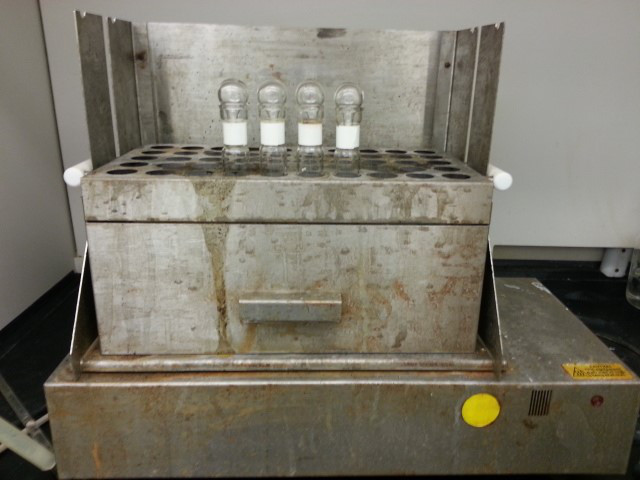Análisis de plomo en el suelo mediante espectroscopia de absorción atómica
Visión general
Fuente: Laboratorios de Margaret obrero y Kimberly Frye - Universidad de Depaul
Plomo se produce naturalmente en el suelo, en niveles que van desde 10-50 ppm. Sin embargo, con el uso generalizado de plomo en la pintura y gasolina además de contaminación por industria, suelos urbanos a menudo tienen concentraciones de plomo significativamente mayor que los niveles de fondo – hasta 10.000 ppm en algunos lugares. Problemas surgen del hecho de que no se biodegradan y en lugar de otro permanece en el suelo.
Riesgos de salud graves están asociados con intoxicación por plomo, donde los niños están particularmente en riesgo. Millones de niños en los Estados Unidos están expuestos al suelo que contienen plomo. Esta exposición puede causar problemas del desarrollo y del comportamiento en niños. Estos problemas incluyen problemas de aprendizaje, falta de atención, retraso en el crecimiento y daño cerebral. La Agencia de protección ambiental ha establecido un estándar para plomo en suelo en 400 ppm para áreas de juego y 1.200 ppm para áreas de juego no.
El plomo es también motivo de preocupación en el suelo, cuando se usa para la jardinería. Las plantas toman el plomo del suelo. Por lo tanto, verduras o hierbas cultivadas en contaminan suelo puede envenenamiento por plomo a plomo. Además, partículas de suelo contaminado pueden ser inhaladas mientras jardinería o traía a la casa de ropa y calzado. Es aconsejable que suelos con niveles de plomo superiores a 400 ppm no deberían utilizarse para la jardinería. Además se recomienda no utilizar suelos con niveles de plomo entre 100 y 400 ppm para hortalizas de hoja o hierbas, porque el plomo puede ser almacenado en las hojas. De forma similar, tubérculos no deben ser crecidos en este suelo, porque plomo también puede acumularse en las raíces de plantas.
Procedimiento
1. colección y preparación del suelo
- En áreas recoger suelo de las 1-2 pulgadas superiores del suelo. Muestreo de hortalizas, recoger muestras de profundas de 6 pulgadas. Use una barrena de suelo para recoger una base de suelo de 1 pulgada de diámetro del área de muestra.
- Homogeneizar la muestra agitando durante 2 minutos y tamizar con un colador de USS #10.
- Secar el suelo en un horno de 40 ° C durante 24 h.
2. digestión de la muestra
- Utilizan
Resultados
El software crea la curva de calibración y determina automáticamente la concentración de Pb en las muestras (figura 2).

Figura 2. La curva de calibración y la concentración de Pb en las muestras determinada automáticamente por el software.
Los valores indicados en la hoja de cálculo son mg/L de Pb en la solución de la m...
Aplicación y resumen
Espectrometría de absorción atómica es una técnica útil para analizar una amplia gama de muestras ambientales (por ejemplo, agua, suelo, lodos y sedimentos) para un gran número de elementos (p. ej., metales pesados). Este experimento pone de relieve el uso de la llama AAS para determinar el contenido de Pb en el suelo. Sin embargo, también podría ser utilizado para medir concentraciones de Cu, Fe, Mn, K, Na, Mg y Zn en los suelos.
El zinc es un micronutriente importan...
Referencias
- Robinson, J.W., Skelly Frame, E.M., Frame II, G.M. Undergraduate Instrumental Analysis. 6th Ed. Marcel Dekker, New York (2005).
- United States Environmental Protection Agency. “Lead based paint poisoning prevention in certain residential structures.” CFR 40 Part 745. http://www.ecfr.gov. (2015).
Saltar a...
Vídeos de esta colección:

Now Playing
Análisis de plomo en el suelo mediante espectroscopia de absorción atómica
Environmental Science
126.1K Vistas

Identificación del árbol: Cómo utilizar una clave dicotómica
Environmental Science
81.4K Vistas

Encuesta sobre árboles: Método de muestreo de cuartos centrados en puntos
Environmental Science
49.5K Vistas

Uso de SIG para investigar silvicultura urbana
Environmental Science
12.7K Vistas

Pilas de combustible de membrana de intercambio protónico
Environmental Science
22.2K Vistas

Biocombustibles: Producción etanol a partir de material celulósico
Environmental Science
53.5K Vistas

Pruebas para alimentos modificados genéticamente
Environmental Science
90.1K Vistas

Turbidez y sólidos totales en aguas superficiales
Environmental Science
35.9K Vistas

Oxígeno disuelto en aguas superficiales
Environmental Science
56.0K Vistas

Nutrientes en ecosistemas acuáticos
Environmental Science
39.0K Vistas

Medición de ozono troposférico
Environmental Science
26.5K Vistas

Determinación de NOx en los gases de escape de los automóviles mediante espectroscopia UV-VIS
Environmental Science
30.3K Vistas

Análisis de carbono y nitrógeno en muestras ambientales
Environmental Science
29.6K Vistas

Análisis de nutrientes del suelo: Nitrógeno, fósforo y potasio
Environmental Science
216.2K Vistas

Análisis de poblaciones de lombrices en el suelo
Environmental Science
16.6K Vistas
ACERCA DE JoVE
Copyright © 2025 MyJoVE Corporation. Todos los derechos reservados
